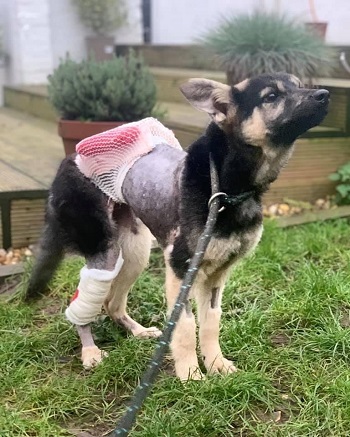Mistreated Dog Saved by RVC Neuro and Orthopaedics Collaboration
Clinical Connections – Summer 2021
A small crossbreed dog that was thrown from a van and found to have multiple injuries made a good recovery thanks to cutting-edge treatment and excellent aftercare at RVC Small Animal Referrals.
Gladys was presented to the referring veterinary practice, via a welfare charity, after a member of the public witnessed her and another dog being thrown from the moving vehicle in London. They managed to catch the dogs and took them to local authority kennels. New Hope Animal Rescue was contacted, funded treatment and has since found homes for both dogs.
Gladys had a microchip, but it was a foreign implant and no details could be obtained, and the van’s number plate was not recorded. The other dog, a lurcher, was emaciated and covered in pressure sores but had no other injuries. Gladys was partially paralysed and unable to walk.
Radiographs taken at the referring practice revealed multiple spinal fractures and so Gladys was referred to the RVC. A CT scan revealed two vertebral fractures. A smaller thoracic vertebral fracture which could be managed medically and a lumbar vertebral body fracture with luxation that required surgery. Additionally, there was an abscess in the muscles surrounding the vertebral fracture, which was thought to originate from the surrounding musculature and a traumatic abdominal wall rupture.
Members of the Neurology and Neurosurgery Service and the Orthopaedic Service worked together to save Gladys. Due to the presence of the abscess and infection, there was a realistic risk that placement of surgical implants would be followed by dramatic wound infection and implant failure. The fracture was therefore stabilised with an external skeletal fixator (ESF) rather than placement of permanent implants. This is a technically complex and very unusual approach for stabilisation of the vertebral column. In addition, she had an exploratory laparotomy due to extension of the paravertebral abscess into the abdomen. Gladys started to improve almost immediately after surgery and was discharged from the hospital after three days.
Though Gladys made a good recovery from surgery, the biggest risk for her immediate health upon discharge was the recurrence of the abscess, which would require further surgery if this did occur. She was consequently monitored closely but there was no resurgence and she made a good recovery.

Gladys returned to the Neurology and Neurosurgery Service eight weeks later for re-examination. Her neurological examination found her to be greatly improved and able to walk again. Repeat CT scan revealed a well aligned vertebral canal and resolution of the abscess. It was decided to consequently remove the external fixator. Despite her ordeal, Gladys remained a sweet and affectionate dog and her story left nobody untouched.
Steven De Decker, head of the Neurology and Neurosurgery team, said: “Gladys’ case was unusual as surgically treated spinal fractures are traditionally managed with internal fixation with pins or plates. As this was not possible due to the active infection associated with the fracture site, external fixation was necessary. ESF provides the required stability to allow for fracture healing with the additional benefit of eventual implant removal. This reduces the chance of implant failure and potentially devastating spread of infection.
“Pins are typically placed bilaterally in at least two vertebral bodies, cranial and caudal, to the fracture site. The pins protrude through the skin to connect to a fixed external structure. Because these types of implants are more commonly used in orthopaedic surgery, a multidisciplinary approach between Neurology and Orthopaedics was utilised to achieve the best result for Gladys. Although a technically challenging and uncommon method, in the right circumstances can have favourable results.”
A spokesman for New Hope Animal Rescue said: “We were amazed by how well physically Gladys did post-surgery, walking so well from the start and growing in strength every day. Her emotional recovery was somewhat slower though – she was clearly traumatised by all that had happened, really shut down and unsure of everything. Slowly we started to see glimmers of personality shine through, and her confidence gradually started to grow.
“Gladys was rehomed shortly after her last check-up at the RVC. She continued to be quite nervous for some time and needed a lot of love and care, but recently she really turned a corner and started to trust again. She lives with other dogs who she adores and who have really helped her rebuild her trust in people. It’s unbelievable to think what she’s been through, and we wanted to give her every chance. Without the expertise of the RVC team this just wouldn’t have been possible.”
